Thermal calculation of a heating system: how to correctly calculate the load on the system
Design and thermal calculation of a heating system is a mandatory stage when arranging home heating.The main task of computational activities is to determine the optimal parameters of the boiler and radiator system.
Agree, at first glance it may seem that only an engineer can carry out thermal engineering calculations. However, not everything is so complicated. Knowing the algorithm of actions, you will be able to independently perform the necessary calculations.
The article describes in detail the calculation procedure and provides all the necessary formulas. For a better understanding, we have prepared an example of a thermal calculation for a private home.
The content of the article:
- Thermal calculation of heating: general procedure
- Standards for room temperature conditions
- Calculation of heat loss in the house
- Determination of boiler power
- Features of the selection of radiators
- Hydraulic calculation of water supply
- Example of thermal calculation
- Conclusions and useful video on the topic
Thermal calculation of heating: general procedure
The classic thermal calculation of a heating system is a consolidated technical document that includes mandatory step-by-step standard calculation methods.
But before studying these calculations of the main parameters, you need to decide on the concept of the heating system itself.
The heating system is characterized by forced supply and involuntary removal of heat into the room.
The main tasks of calculating and designing a heating system:
- most reliably determine heat losses;
- determine the amount and conditions of use of the coolant;
- select the elements of generation, movement and heat transfer as accurately as possible.
During construction heating systems It is necessary to initially collect a variety of data about the room/building where the heating system will be used. After calculating the thermal parameters of the system, analyze the results of arithmetic operations.
Based on the data obtained, heating system components are selected, followed by purchase, installation and commissioning.
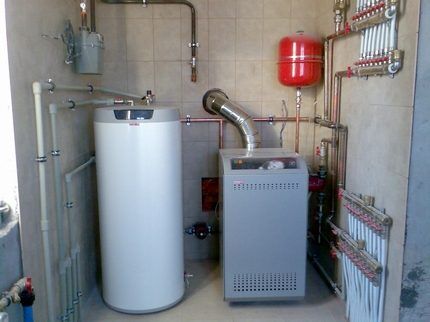
It is noteworthy that this thermal calculation method allows one to quite accurately calculate a large number of quantities that specifically describe the future heating system.
As a result of the thermal calculation, the following information will be available:
- number of heat losses, boiler power;
- number and type of thermal radiators for each room separately;
- hydraulic characteristics of the pipeline;
- volume, coolant speed, heat pump power.
Thermal calculations are not theoretical sketches, but rather accurate and reasonable results that are recommended to be used in practice when selecting heating system components.
Standards for room temperature conditions
Before carrying out any calculations of system parameters, it is necessary, at a minimum, to know the order of the expected results, and also to have standardized characteristics of some tabular values that need to be substituted into formulas or be guided by them.
By calculating parameters with such constants, you can be confident in the reliability of the desired dynamic or constant parameter of the system.
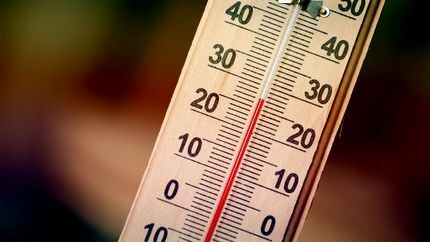
For a heating system, one of these global parameters is the room temperature, which must be constant regardless of the season and environmental conditions.
According to the regulations of sanitary standards and rules, there are differences in temperature relative to the summer and winter periods of the year.The air conditioning system is responsible for the temperature regime of the room in the summer season; the principle of its calculation is described in detail in this article.
But the room temperature in winter is provided by the heating system. Therefore, we are interested in temperature ranges and their deviation tolerances for the winter season.
Most regulatory documents stipulate the following temperature ranges that allow a person to stay comfortably in the room.
For non-residential office premises with an area of up to 100 m2:
- 22-24°С — optimal air temperature;
- 1°С — permissible fluctuation.
For office premises with an area of more than 100 m2 the temperature is 21-23°C. For non-residential industrial premises, temperature ranges vary greatly depending on the purpose of the room and established labor protection standards.

As for residential premises: apartments, private houses, estates, etc., there are certain temperature ranges that can be adjusted depending on the wishes of the residents.
And yet, for specific premises of an apartment and house we have:
- 20-22°С - living room, including children's room, tolerance ±2°С -
- 19-21°С — kitchen, toilet, tolerance ±2°С;
- 24-26°C — bathroom, shower, swimming pool, tolerance ±1°С;
- 16-18°С — corridors, hallways, staircases, storage rooms, tolerance +3°C
It is important to note that there are several more basic parameters that affect the temperature in the room and which you need to focus on when calculating the heating system: humidity (40-60%), concentration of oxygen and carbon dioxide in the air (250:1), air movement speed mass (0.13-0.25 m/s), etc.
Calculation of heat loss in the house
According to the second law of thermodynamics (school physics), there is no spontaneous transfer of energy from less heated to more heated mini- or macro-objects. A special case of this law is the “striving” to create temperature equilibrium between two thermodynamic systems.
For example, the first system is an environment with a temperature of -20°C, the second system is a building with an internal temperature of +20°C. According to the above law, these two systems will strive to balance through the exchange of energy. This will happen with the help of heat losses from the second system and cooling in the first.
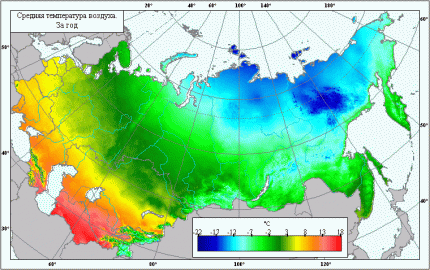
Heat loss refers to the involuntary release of heat (energy) from some object (house, apartment). For an ordinary apartment, this process is not so “noticeable” in comparison with a private house, since the apartment is located inside the building and “adjacent” to other apartments.
In a private house, heat escapes to one degree or another through the external walls, floor, roof, windows and doors.
Knowing the amount of heat loss for the most unfavorable weather conditions and the characteristics of these conditions, it is possible to calculate the power of the heating system with high accuracy.
So, the volume of heat leakage from the building is calculated using the following formula:
Q=Qfloor+Qwall+Qwindow+Qroof+Qdoor+…+Qi, Where
Qi — the volume of heat loss from a homogeneous type of building shell.
Each component of the formula is calculated using the formula:
Q=S*∆T/R, Where
- Q – heat leakage, V;
- S – area of a specific type of structure, sq. m;
- ∆T – difference in ambient and indoor air temperatures, °C;
- R – thermal resistance of a certain type of structure, m2*°C/W.
It is recommended to take the very value of thermal resistance for real existing materials from auxiliary tables.
Additionally, the thermal resistance can be obtained using the following relationship:
R=d/k, Where
- R – thermal resistance, (m2*K)/W;
- k – coefficient of thermal conductivity of the material, W/(m2*TO);
- d – thickness of this material, m.
In old houses with damp roofing structures, heat leaks occur through the upper part of the building, namely through the roof and attic. Carrying out activities on ceiling insulation or thermal insulation of attic roof solve this problem.
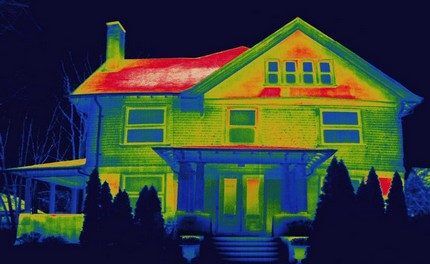
There are several other types of heat loss in the house through cracks in structures, ventilation systems, kitchen hoods, and opening windows and doors. But it makes no sense to take into account their volume, since they constitute no more than 5% of the total number of main heat leaks.
Determination of boiler power
To maintain the temperature difference between the environment and the temperature inside the house, an autonomous heating system is required, which maintains the desired temperature in each room of a private house.
The heating system is based on different types of boilers: liquid or solid fuel, electric or gas.
A boiler is the central unit of a heating system that generates heat. The main characteristic of a boiler is its power, namely the rate of conversion of the amount of heat per unit of time.
After calculating the heating load, we obtain the required rated power of the boiler.
For an ordinary multi-room apartment, the boiler power is calculated through the area and specific power:
Rboiler=(Spremises*Rspecific)/10, Where
- Spremises — total area of the heated room;
- Rspecific — specific power relative to climatic conditions.
But this formula does not take into account heat losses, which are sufficient in a private house.
There is another ratio that takes this parameter into account:
Rboiler=(Qlosses*S)/100, Where
- Rboiler — boiler power;
- Qlosses — heat loss;
- S - heated area.
The design power of the boiler needs to be increased. The reserve is necessary if you plan to use the boiler to heat water for the bathroom and kitchen.
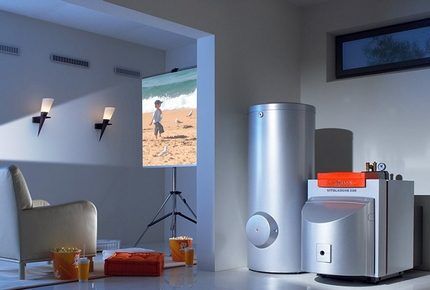
In order to provide for the boiler power reserve, the safety factor K must be added to the last formula:
Rboiler=(Qlosses*S*K)/100, Where
TO — will be equal to 1.25, that is, the design power of the boiler will be increased by 25%.
Thus, the boiler power makes it possible to maintain the standard air temperature in the rooms of the building, as well as to have an initial and additional volume of hot water in the house.
Features of the selection of radiators
Standard components for providing heat in a room are radiators, panels, underfloor heating systems, convectors, etc.The most common parts of a heating system are radiators.
The thermal radiator is a special hollow modular-type structure made of an alloy with high heat dissipation. It is made of steel, aluminum, cast iron, ceramics and other alloys. The principle of operation of a heating radiator is reduced to the radiation of energy from the coolant into the space of the room through the “petals”.
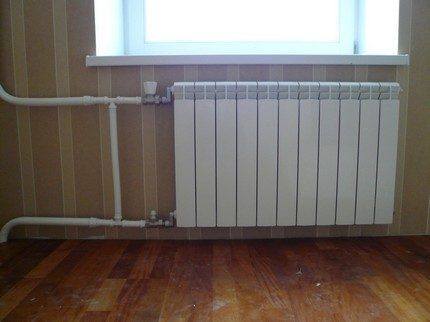
There are several methods heating radiator calculations in the room. The list of methods below is sorted in order of increasing calculation accuracy.
Calculation options:
- By area. N=(S*100)/C, where N is the number of sections, S is the area of the room (m2), C - heat transfer of one section of the radiator (W, taken from the passport or certificate for the product), 100 W - the amount of heat flow that is necessary to heat 1 m2 (empirical value). The question arises: how to take into account the height of the ceiling of the room?
- By volume. N=(S*H*41)/C, where N, S, C are similar. H - room height, 41 W - amount of heat flow required to heat 1 m3 (empirical value).
- By odds. N=(100*S*k1*k2*k3*k4*k5*k6*k7)/C, where N, S, C and 100 are the same. k1 - taking into account the number of chambers in a double-glazed window of a room, k2 - thermal insulation of walls, k3 - ratio of window area to room area, k4 - average sub-zero temperature in the coldest week of winter, k5 - number of external walls of a room (which “extend” to the street), k6 - type of room above, k7 - ceiling height.
This is the most accurate option for calculating the number of sections. Naturally, fractional calculation results are always rounded to the next integer.
Hydraulic calculation of water supply
Of course, the “picture” of calculating heat for heating cannot be complete without calculating such characteristics as the volume and speed of the coolant. In most cases, the coolant is ordinary water in a liquid or gaseous aggregate state.

Calculation of the volume of water heated by a double-circuit boiler to provide residents with hot water and heat the coolant is made by summing the internal volume of the heating circuit and the actual needs of users for heated water.
The volume of hot water in the heating system is calculated by the formula:
W=k*P, Where
- W — volume of coolant;
- P — heating boiler power;
- k - power factor (number of liters per unit of power, equal to 13.5, range - 10-15 liters).
As a result, the final formula looks like this:
W = 13.5*P
Coolant velocity is the final dynamic assessment of a heating system, which characterizes the rate of fluid circulation in the system.
This value helps to evaluate the type and diameter of the pipeline:
V=(0.86*P*μ)/∆T, Where
- P — boiler power;
- μ — boiler efficiency;
- ∆T - temperature difference between supply water and return water.
Using the above methods hydraulic calculation, it will be possible to obtain real parameters that are the “foundation” of the future heating system.
Example of thermal calculation
As an example of a thermal calculation, we have an ordinary 1-story house with four living rooms, a kitchen, a bathroom, a “winter garden” and utility rooms.

Let us designate the initial parameters of the house necessary for the calculations.
Building dimensions:
- floor height - 3 m;
- small window on the front and rear of the building 1470*1420 mm;
- large facade window 2080*1420 mm;
- entrance doors 2000*900 mm;
- rear doors (exit to the terrace) 2000*1400 (700 + 700) mm.
The total width of the building is 9.5 m2, length 16 m2. Only living rooms (4 units), a bathroom and a kitchen will be heated.

We start by calculating the areas of homogeneous materials:
- floor area - 152 m2;
- roof area - 180 m2 , taking into account the height of the attic is 1.3 m and the width of the purlin is 4 m;
- window area - 3*1.47*1.42+2.08*1.42=9.22 m2;
- door area - 2*0.9+2*2*1.4=7.4 m2.
The area of the external walls will be 51*3-9.22-7.4=136.38 m2.
Let's move on to calculating heat loss for each material:
- Qfloor=S*∆T*k/d=152*20*0.2/1.7=357.65 W;
- Qroof=180*40*0.1/0.05=14400 W;
- Qwindow=9.22*40*0.36/0.5=265.54 W;
- Qdoors=7.4*40*0.15/0.75=59.2 W;
And also Qwall equivalent to 136.38*40*0.25/0.3=4546. The sum of all heat losses will be 19628.4 W.
As a result, we calculate the boiler power: Pboiler=Qlosses*Sheating_rooms*K/100=19628.4*(10.4+10.4+13.5+27.9+14.1+7.4)*1.25/100=19628.4*83.7*1.25/100=20536.2=21 kW.
We will calculate the number of radiator sections for one of the rooms. For all others, the calculations are similar. For example, a corner room (on the left, lower corner of the diagram) has an area of 10.4 m2.
This means N=(100*k1*k2*k3*k4*k5*k6*k7)/C=(100*10.4*1.0*1.0*0.9*1.3*1.2*1.0*1.05)/180=8.5176=9.
This room requires 9 sections of heating radiator with a heat output of 180 W.
Let's move on to calculating the amount of coolant in the system - W=13.5*P=13.5*21=283.5 l. This means that the coolant speed will be: V=(0.86*P*μ)/∆T=(0.86*21000*0.9)/20=812.7 l.
As a result, a complete turnover of the entire volume of coolant in the system will be equivalent to 2.87 times per hour.
A selection of articles on thermal calculations will help you determine the exact parameters of the heating system elements:
- Calculation of the heating system of a private house: rules and calculation examples
- Thermal engineering calculation of a building: specifics and formulas for performing calculations + practical examples
Conclusions and useful video on the topic
A simple calculation of a heating system for a private home is presented in the following review:
All the subtleties and generally accepted methods for calculating the heat loss of a building are shown below:
Another option for calculating heat leaks in a typical private house:
This video describes the features of the circulation of energy carriers for heating a home:
Thermal calculation of a heating system is individual in nature and must be performed competently and carefully. The more accurately the calculations are made, the less the owners of a country house will have to overpay during operation.
Do you have experience performing thermal calculations of a heating system? Or still have questions on the topic? Please share your opinion and leave comments. The feedback block is located below.




In my opinion, such calculations are not feasible for every average person. Many people prefer to simply pay money to professionals working in this field and get the finished result. But as for reducing heat loss, everyone needs to think about it personally and insulate their home. Nowadays there is quite a wide selection of materials for a variety of wallets.
I would argue with you. You know, at first it also seemed to me that there was no way I could figure this out, there was a huge number of formulas and concepts that were previously unknown to me. But I still decided to try. And you know, if you sit down and go a little deeper into the analysis, there’s nothing complicated here, in general. The eyes are afraid, as they say!
I don’t have any special education, but I believe that a man in the house should do everything with his own hands (if possible, of course)
Thank you very much for the article, I will say: everything is very clear based on school physics. I am an electronics engineer, I am involved in the automation of boiler houses and other systems, and later I started installing heating and water supply systems, I want to learn the whole principle of operation and calculation myself, a very useful article. Thank you.